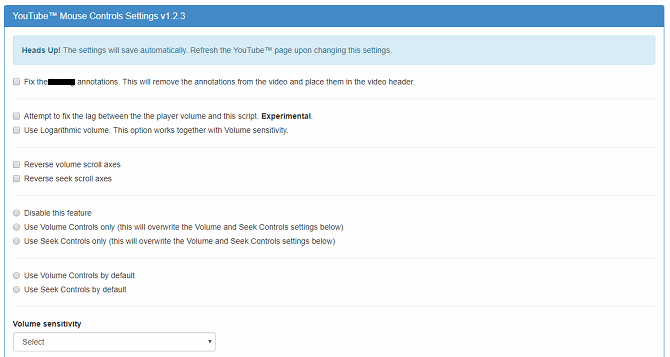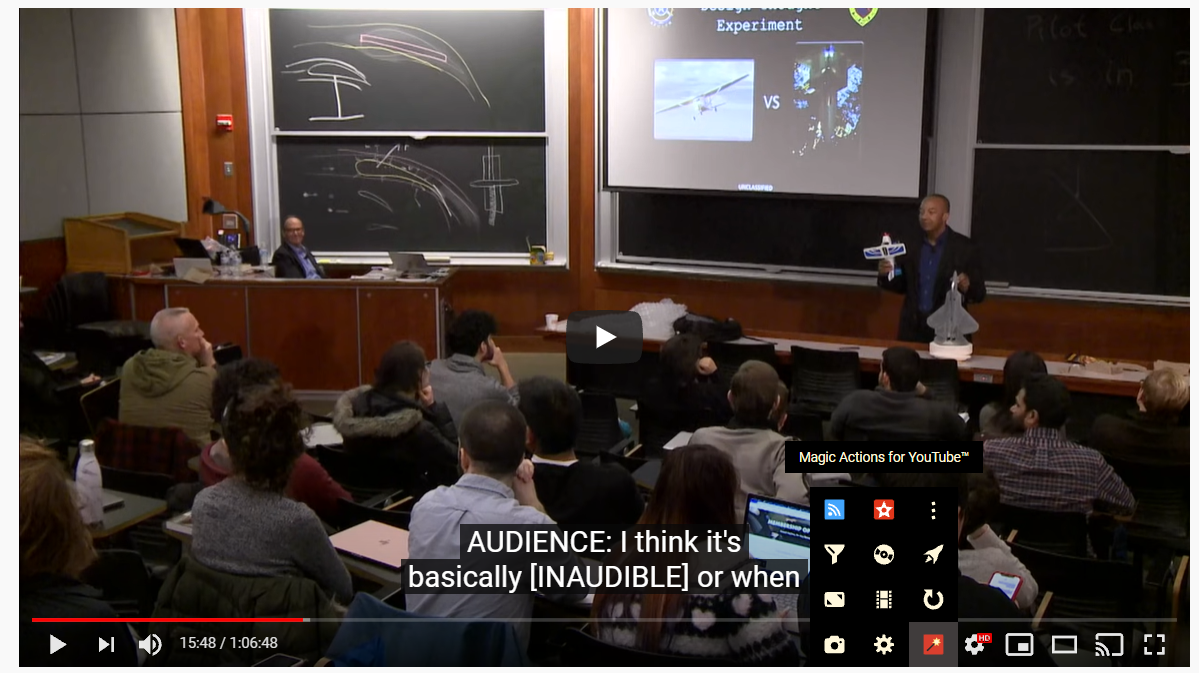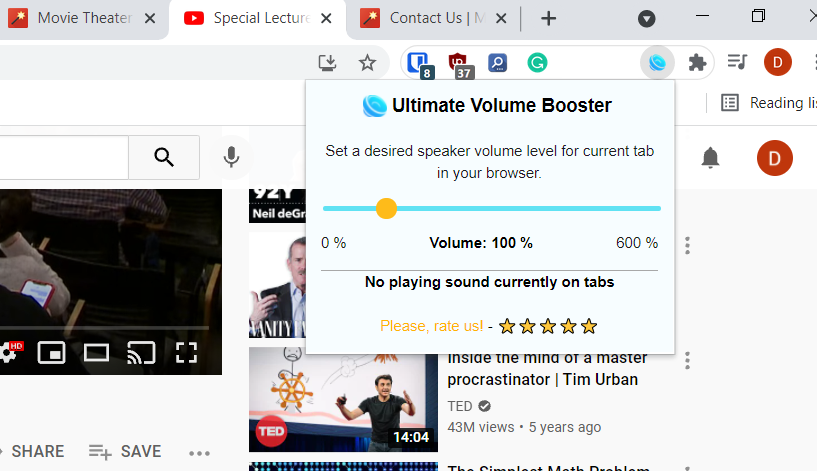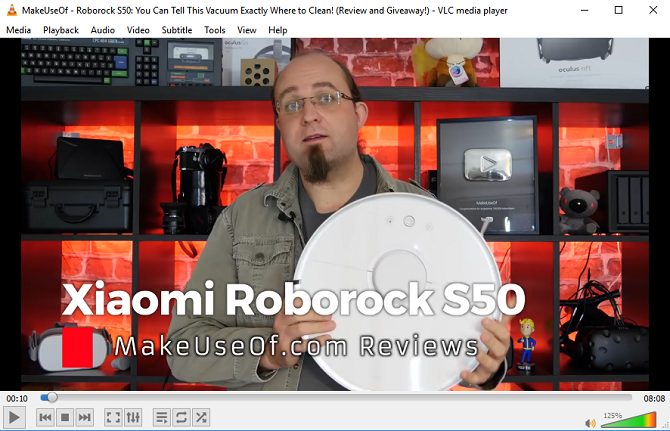Who knew that controlling the volume of YouTube videos could be such a complex topic? After all, what options do you really have beyond the on-screen slider? You'd be surprised, actually.
It turns out there are multiple different ways to control YouTube video volume. Here are some of the best methods we've found.
1. Volume Slider
Let's kick off with the on-screen slider. It's the primary way that most people adjust YouTube's volume.
The slider is self-explanatory. Move it to the left to decrease volume and move it to the right to make YouTube louder.
There's also a mute function to instantly kill the sound; just click on the speaker icon.
2. Keyboard Shortcuts
We always advocate using keyboard shortcuts for any task where possible. Learn them well, and they are faster than using a mouse, meaning you can be more productive.
YouTube is no different. There are a plethora of handy YouTube keyboard shortcuts available. You can do everything from skipping the video to turning subtitles on and off.
YouTube's keyboard shortcuts for volume control are the arrow keys. Pressing Up will increase the volume in five percent increments; pressing Down will decrease the volume by the same amount.
If the shortcuts aren't working, try clicking on the video first. If the video is not in focus in your browser, you might find that the arrow keys scroll the entire webpage up and down instead.
Third-Party YouTube Volume Controls
When it comes to controlling YouTube's volume, you aren't only limited to the native functionality. There are a host of third-party YouTube extensions and extensions which provide extra features. Some of them let you adjust the volume of YouTube videos.
3. YouTube Mouse Controls
Available on: Chrome
If you're running Google Chrome, you should start by checking out the YouTube Mouse Controls extension.
It lets you make YouTube louder and quieter by using the scroll wheel on your mouse. It will work as long as your mouse cursor is hovering somewhere over the video player.
You can also use the extension to seek through videos. Click the scroll wheel and move your mouse left or right. Click the scroll wheel for a second time when you're ready to start watching.
You need to access the extension settings page to activate it before the mouse controls will work.
Download: YouTube Mouse Controls (Free)
4. Magic Actions for YouTube
Available on: Chrome
The second Chrome extension worth talking about is Magic Actions for YouTube. It is a more full-featured add-on than YouTube Mouse Controls.
In addition to letting you use your mouse to adjust the volume, it also offers a cinema view, auto HD, day and night viewing modes, automatic video replays, one-click video screenshots, an easy way to view and delete your watch history, rating previews for Related Videos, and more information about users in the comments section.
Once installed, you can access the features via a new button that appears at the bottom of the YouTube video's window.
Download: Magic Actions for YouTube (Free)
5. Ultimate Volume Booster
Available on: Chrome
Controlling YouTube's volume isn't only about making a video louder or quieter. There are times when you might need to boost the volume beyond what YouTube natively allows (for example, if the person speaking in a video has endured microphone issues.)
For those instances, you should use Ultimate Volume Booster. You can edit the volume level to more than 600% of the regular maximum, allowing to hear even the quietest videos.
Using this extension on loud videos can irreparably damage your computer's speakers. Use it wisely.
Download: Ultimate Volume Booster (Free)
Other Ways to Control YouTube Video Volume
Let's finish by looking at two more ways to control the YouTube video volume that you may not have thought of previously.
6. VLC Media Player
Available on: Windows, Mac, Linux, Android, iOS
If the volume is low on a YouTube video you want to watch, you could also consider watching the video directly through VLC Media Player. It lets you make YouTube louder thanks to its sound booster.
Sure, it might be a bit too much hassle for a two-minute video of a cat doing catty things, but if it's a movie or similarly long video that you're struggling to hear, you'll reap the rewards.
To watch a YouTube video on VLC Media Player, follow the step-by-step instructions below:
- Download and open VLC Media Player.
- Head to YouTube and copy (Ctrl + C) the URL of the video you want to watch.
- On VLC, navigate to Media > Open Capture Device.
- Click on the Network tab.
- Paste the YouTube URL that you copied in Step Two.
- Click on Play.
After a couple of moments, the video should start playing. You can then use the volume slider in the lower right-hand corner to boost the volume to 125 percent of its original maximum.
Download: VLC Media Player (Free)
7. Normalize Audio Output on Your PC
YouTube doesn't have a native way to normalize audio output. Instead, you should use third-party tools.
Windows has a built-in tool. You can activate the operating system's loudness equalization by right-clicking on the speaker icon in the taskbar and heading to Sounds > Playback > Speakers > Properties > Enhancements and marking the checkbox next to Loudness Equalization. Not all speakers support this feature.
If you're using macOS, there's no built-in loudness normalization tool. Luckily, there are plenty of third-party equalizers that do the job perfectly well. Two of the most popular are Boom and eqMac2.
Windows also has third-party sound equalizers if you don't like the native functionality.
Get the Volume Just Right
There you have it. A multitude of different ways to control YouTube video volume. They won't all be necessary all the time, but when you need different ways to control the audio output at a more granular level, they can be a lifesaver.






